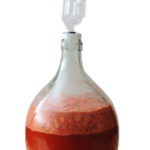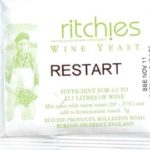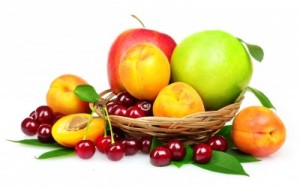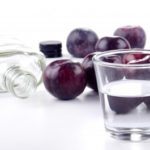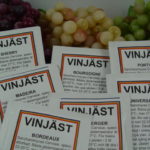Fermentacja i wybór drożdży
Do przygotowanego nastawu (miazga owocowa lub sok + pierwsza porcja syropu cukrowego) o temp. startowej 18 – 200C, dodajemy pożywkę w ilości 3-5g na 10L, według zasady, że im bardziej rozcieńczony moszcz tym więcej pożywki. Pożywka, której głównym składnikiem jest fosforan dwuamonowy, jest niezbędna do odpowiedniego namnożenia drożdży i prawidłowego przebiegu fermentacji. Dostępne są następujące rodzaje pożywek:
- Pożywka podstawowa – pożywka mineralna, której głównym składnikiem jest fosforan dwuamonowy, dodaje się ją do moszczu w ilości 3-5g na 10L nastawu.
- Pożywka z witaminą B1 np.: ENARTIS NUTRIFERM SUPERVIT – zawiera oprócz fosforanu dwuamonowego dodatek witaminy B1, oraz dekstryn wiążących substancje toksyczne dla drożdży, dodaje się ją w ilości 5g na 10L nastawu. Witamina B1 stymuluje wzrost drożdży i jest silnym aktywatorem fermentacji. 15g/50l pożywki ENRTIS NUTRIFERM SUPERVIT dostarcza do nastawu 30mg/50l Vit.B1 – maksymalna dawka dla UE.
- Pożywka KOMBI np.: ENARTIS NUTRIFERM SPECIAL – zawiera oprócz fosforanu dwuamonowego i witaminy B1, preparaty ścian komórkowych drożdży, które wykazują zdolność absorbowania substancji hamujących fermentację, między innymi kwasów tłuszczowych. Dodaje się ją w ilości 3g na 10L. Jest najczęściej stosowana w przypadku owoców trudno fermentujących (np.: jabłka, gruszki etc.), moszczów silnie rozcieńczonych, miodów oraz przy restartach win (wznowienie fermentacji po tym, jak wino przestanie pracować zbyt wcześnie).
- Pożywka wieloskładnikowa ENARTIS NUTRIFERM START – wieloskładnikowa pożywka nowego typu – energetyczna, przygotowana w celu bardzo szybkiego zainicjowania fermentacji alkoholowej, zalecana w przypadku zatrzymania się fermentacji, zawiera vit.B1, dawkowanie 20g na 60 do 100 litrów nastawu, 20g na 50litrow w przypadku zatrzymanej fermentacji
- Pożywka ENARTIS NUTRIFERM AROM – najbardziej zaawansowana pożywka na rynku – w skład której wchodzą witaminy oraz specjalnie wyselekcjonowane komórki drożdżowe z wysoką zawartością aminokwasów. Wolne aminokwasy są najważniejszą substancją, są prekursorami by zsyntetyzować najważniejsze substancje powstające w procesie fermentacji /alkohole, estry, aldehydy, glicerol, etc./, które przyczyniają się do powiększania aromatycznej intensywności i złożoności win. Aby w maksymalnym stopniu wykorzystać pożywkę NUTIFERM AROM zalecamy użycie drożdży Challenege AromaWhite lub Challenge RedFruit, które posiadają największą metaboliczną zdolność by przekształcić wolne aminokwasy w aromatyczne substancje.
Następnym krokiem jest dodanie szlachetnych drożdży winiarskich, które należy wlać zaraz po przygotowaniu nastawu. Dodanie drożdży winiarskich ograniczy niekontrolowaną fermentację, spowodowaną przez dzikie drożdże, żyjące na powierzchni owoców.
Drożdże dzikie należą do grupy drożdży słabo fermentujących, odznaczających się niską odpornością na alkohol – dla większości z nich górną granicą odporności jest 4% objętości alkoholu. Ponieważ nie jesteśmy w stanie określić szczepu który rozwija się na naszych owocach, to nie możemy określić efektu końcowego fermentacji na drożdżach dzikich. Sporadycznie może się zdarzyć szczep, który jest w stanie przefermentować całkowicie cukier zawarty w moszczu, ale z reguły otrzymuje się wówczas słabe wina zarówno w smaku jak i zawartości procentowej alkoholu (6-9%) – przy tym nietrwałe i narażone na choroby, nienadające się do dłuższego przechowywania.
Poważnym zagrożeniem fermentacji na drożdżach dzikich jest także nadmierne wytwarzanie kwasu octowego i jego estrów przez licznie występujące drożdże dzikie Apiculatus. Dlatego zawsze polecamy stosowanie szlachetnych drożdży winiarskich odpowiednio dobranych do rodzaju i koloru nastawu oraz warunków fermentacji np.: temperatury.
Jeśli stosujemy tradycyjne drożdże winiarskie, dostępne w formie suchej lub płynnej, musimy przygotować
z nich matkę drożdżową (tak określa się sposób, namnażania drożdży przed dodaniem ich do nastawu). Matkę drożdżową przygotowujemy na 2-3 dni przed nastawem, według przepisu, który znajdziemy na każdej paczce drożdży. Należy pamiętać, że aby drożdże się prawidłowo namnożyły, należy trzymać je w ciepłym miejscu
(o stałej temperaturze ok.260C – 300C) aż do powstania obfitej piany. Drożdże dobieramy w zależności od owoców i koloru wina oraz planowanej mocy. Sposób doboru drożdży przedstawia tabela Nr 2.
Możemy zastosować również Aktywne Drożdże Winiarskie, które nie wymagają wcześniejszych przygotowań. Uaktywnia się je po wsypaniu do 150-200ml przegotowanej wody o temp. ok. 300C (lub w innej temperaturze wskazanej na ulotce z drożdżami). Po wymieszaniu i odczekaniu 20-30min., tak przygotowaną matkę drożdżową wlewa się do nastawu. Rodzaj drożdży aktywnych wybiera się w zależności od sposobu fermentacji i rodzaju nastawu:
- ENARTIS Ferm EzFerm – szczep wyselekcjonowany ze względu na swoją wyjątkową siłę – skutecznie wznawia zatrzymaną fermentację, nawet w bardzo trudnych warunkach (przy zachowaniu odpowiedniej procedury). Umożliwia uzyskanie ponad 18% alkoholu. Zalecane też do ciężkich nastawów.
- ENARTIS Ferm AromaWhite – zalecane głównie do produkcji świeżych i owocowych win białych oraz różowych win z intensywnym owocowym charakterem. Neutralne w zapachu i smaku, pozwalają uzyskać pełny bukiet owoców w winie.
- ENARTIS Ferm Red Fruit – dedykowane do produkcji świeżych i owocowych win czerwonych, oraz win jakościowych jak: Cabernet Sauvignon, Merlot, Shiraz, etc. Wprowadza fermentację malolactic, charakteryzuje się niskim pienieniem i dużą produkcją glicerolu. Wzmacnia czerwony kolor oraz bukiet wina.
- ENARTIS Ferm SC – uniwersalne drożdże winiarskie, dedykowane do win białych i różowych. Zachowują w winie aromat użytych owoców, efekt końcowy okrągły i pełny smak.
- ENARTIS Ferm EsPerlage – dedykowane do produkcji świeżych i intensywnie owocowych win białych, różowych oraz do win musujących. Charakteryzują się wysoką produkcja glicerolu i niską produkcją kwasowości.
- Oenoferm Riesling – drożdże niskoalkoholizujące, dedykowane do lekkich i owocowych win typu Riesling.
- Oenoferm PinoType – dedykowane do lekkich, świeżych i owocowych win różowych i czerwonych, dedykowane do szczepów PinotNoir, PinotBlanc, PinotGris, Chardonnay, win typu Burgund.
Należy pamiętać, aby różnica temperatur między matką drożdżową, a nastawem nie była większa niż 80C.
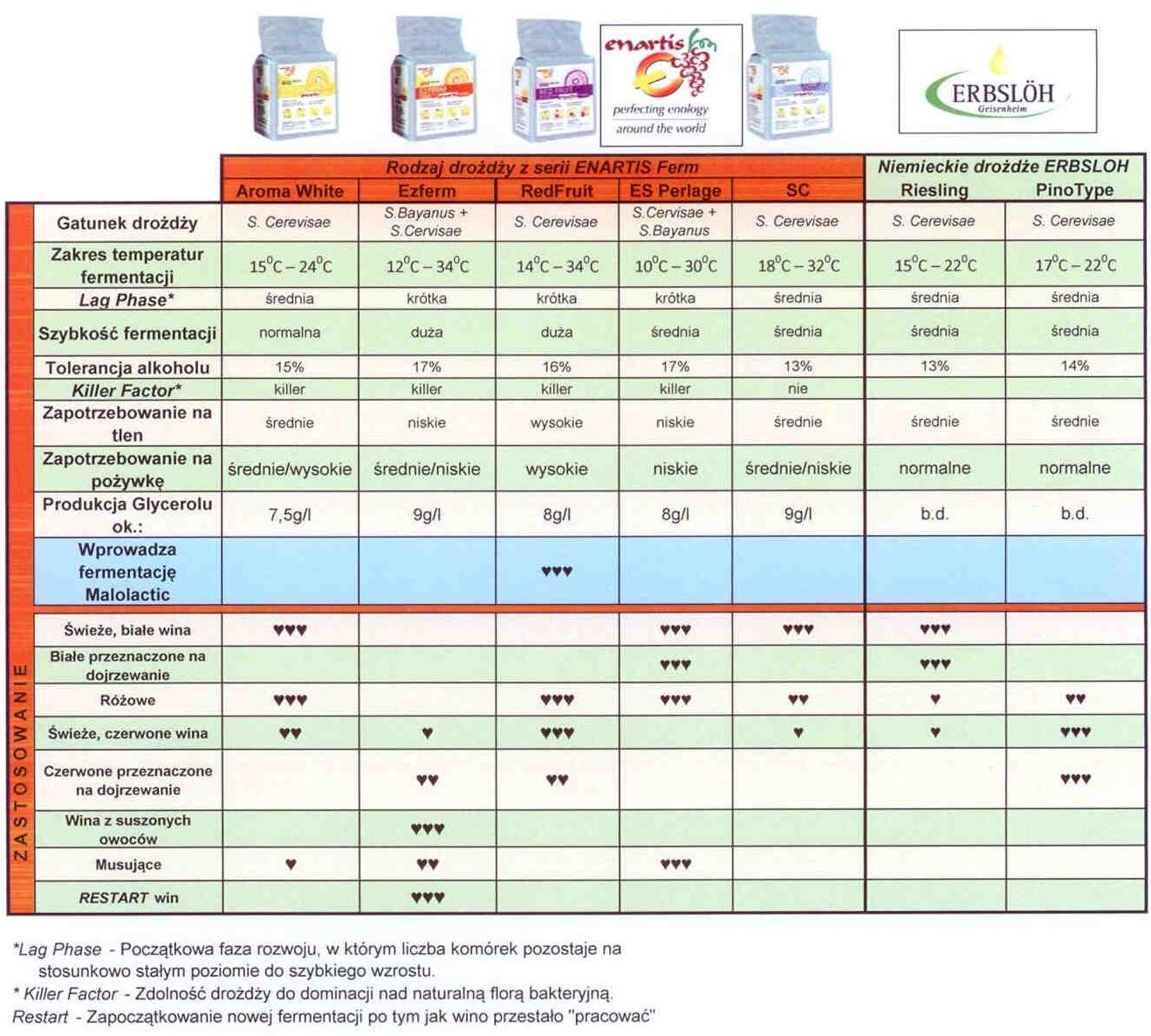
Znaleziono w Google poprzez:
- jak zrobic wino z jabłek
- jak zrobic wino z czerwonej porzeczki
- drożdże winiarskie
- drozdze do wina
- jak zrobić drożdże winne
- jak zrobic pozywke do wina
- drożdże winiarskie warszawa
